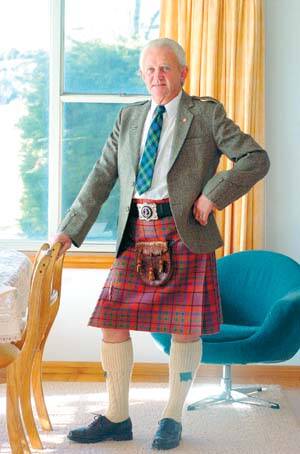
TASMANIA'S only earl and countess will return to London again in November - and this time the Countess of Dunmore will pack her tiara.
Subscribe now for unlimited access.
or signup to continue reading
In 1998, the Countess and the 12th Earl of Dunmore - technician Malcolm Murray of Wesley Vale - took their seats inside Britain's Houses of Parliament for the first time.
The Tasmanian-born Scottish earl delivered his first and last speech to the House of Lords - a passionate talk about the Blair Government's push to remove hereditary peers like himself from the House.
Sitting on a red leather couch nearby, the Countess of Dunmore realised to her embarrassment that she was one of only two women in the House not wearing a tiara.
"I was sitting directly behind the royal family and I did feel very out of place," the countess - Joy Murray - said.
"But I have a tiara now and will be wearing it next time."
The older a title is, the more privileges it attracts.
Lord Murray's earldom dates back to 1686, when it was created for the second son of the Marquess of Athol, who became the first Earl of Dunmore.
The 12th Earl of Dunmore is not what you might expect.
Lord Murray is also the Viscount of Fincastle and Lord Murray of Blair, Moulin and Tillimet. He has visited, and felt a connection to, all the places to which he has a hereditary link.
Lord Murray is also the High Commissioner of Clan Murray in Australia and New Zealand and one of 92 hereditary peers sitting in the House of Lords.
But the small, quietly spoken man who opens the door of his standard brick-and-tile house on sweeping farmland at Wesley Vale does not appear to have a pompous bone in his body.
He shudders at the thought of using his title to win favours at restaurants and hotels and does not tell all and sundry about his connections. But he does wear the ancient Murray tartan with pride - all 8m of it.
"We are just normal people," Lord Murray said.
"My father Ken, who inherited the title in 1982 and was the first Tasmanian to sit in the House of Lords, was just a normal person too. His new title did not change him."
While few Tasmanians might realise that an earl lives in our midst, Lord Murray was headline news in London in 1998 - the height of the Blair Government's push to rid the House of Lords of hereditary peers.
He remembers the many messages he received while sitting in the House from a media pack eager to paint him as the quintessential hereditary peer - a colonial on his first trip to the Mother Country.
Lord Murray also remembers the brief conversation he had with British Prime Minister Margaret Thatcher on his first visit to London.
He had left the House as a vote was taken and was waiting outside when he recognised the woman he was standing next to.
"You're Mrs Thatcher," Lord Murray said.
"And you are the Aussie earl," she replied.
Not many people in London at that time did not know who the 12th Earl of Dunmore was.
He was on the front page of the Times and dressed as a pineapple in one of the city's trashier tabloids.
The pineapple gibe related to the 4th Earl of Dunmore, who took pineapple seeds to England from the Americas.
He was growing the fruit in a hothouse on the Dunmore estate.
So fond of the tropical delight was the 4th Earl of Dunmore that he built a 12m- high sandstone pineapple turret on Dunmore's castle.
A picture of this sandstone pineapple is on the wall of the Murrays' Wesley Vale home along with swords that have been danced over, Edinburgh crystal and a Scottish leather fighting shield.
On their latest visit to the UK, the 12th Earl of Dunmore and his countess will be meeting up with the Duke of Athol, who will be visiting Britain from South Africa to inspect his private army.
The countess admits it is exciting being married to an earl.
"I love to meet people and we do a lot of that," she said.
The Murrays can still sit in the House of Lords, but under the new rules, they now have to ask.
Lord Murray is the patron of the Murray Clan of Victoria and the Murray Clan of New Zealand, patron and co-founder of the Murray clan of Queensland, and patron of the Tasmanian Caledonian Council, St Andrew's Society Tasmania, the Armorial and Heraldry Society of Australasia, the Scottish Australian Heritage Council and the Company of Armigers Australia.
He is also an honorary member of the Murray clan of NSW.
In 2004, he was recognised as a Friend to the Celts by the Celtic Council of Australia for services to the Celtic Society in Australia.













